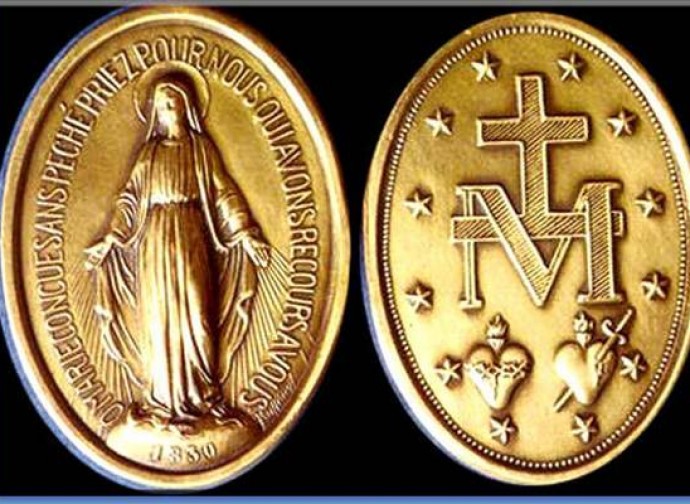Blessed Virgin of the Miraculous Medal
On 27 November 1830, the Blessed Virgin appeared to Catherine Labouré (1806-1876), novice of the Daughters of Charity in the Parisian convent on Rue du Bac. The saint, next to the picture of St Joseph, saw Our Lady wearing a white dress like the dawn, a blue mantle and a long white veil, standing on a half globe enveloped in the coils of a snake.

On 27 November 1830, the Blessed Virgin appeared to Catherine Labouré (1806-1876), novice of the Daughters of Charity in the Parisian convent on Rue du Bac, who was meditating in the chapel in deep silence. It was half past five in the afternoon. The saint, next to the picture of St Joseph, saw Our Lady wearing a white dress like the dawn, a blue mantle and a long white veil, standing on a half globe enveloped in the coils of a snake.
The Heavenly Mother tenderly held another smaller, golden globe in her hands and with a glowing face presented it to Our Lord. “This little globe symbolises the whole world and each soul in particular!” Catherine heard her say. She suddenly saw Mary's fingers covered with rings, adorned with precious stones radiating beams of light downwards. “The rays are the symbol of the graces that I spread on those who ask me for them,” said Our Lady, who explained why other precious stones did not radiate light: “They are the graces that one forgets to implore”.
Catherine then saw an oval painting form around the Virgin, on which she read a prayer written in golden letters: “O Mary, conceived without sin, pray for us who have recourse to You”. She observed the painting turn round and saw the letter M intersected by the I (of Iesus) and surmounted by a cross. Below her appeared the Sacred Hearts of Jesus and Mary, the first surrounded by thorns, the second pierced by a sword (cf. Lk 2:35). The vision was accompanied by the heavenly request: “Have a medal forged on this model. All the people who wear it will receive great graces, especially by wearing it around their necks. The graces will be abundant for those who wear it with confidence”.
After disarming her confessor’s initial resistance, the message given to Catherine finally reached the Archbishop of Paris, Jacinto Louis de Quélen, who approved the coining of the medal. Monsignor Quélen asked only to have the prudence that the Church recommends for every private revelation: “Do not make premature judgments about the nature of the vision, nor reveal the circumstances. Let this medal simply spread. And the tree will be judged by its fruits”.
The first 1,500 replicas of the medal were ready in the summer of 1832, when Paris was in the midst of a cholera epidemic. The fruits did not take long to appear. It was the people who soon called it “miraculous” (the use of this description is documented since February 1834), precisely because of the innumerable graces, consisting of both physical healings (above all, we remember that of Carolina Nenain, an 8-year-old girl inexplicably cured of cholera after wearing the medal) and even more spiritual healings (the best known is the sudden conversion, which took place in Rome in 1842, of the then atheist and mocker of Christianity Alphonse Ratisbonne). By 1835 there were already more than a million medals in circulation, which would reach one billion copies on the death of St Catherine. There was an extraordinary revival of the Daughters of Charity of St Vincent de Paul, who in little more than twenty years attracted so many vocations that they had to triple the number of their houses. Then, in the light of these facts, Leo XIII instituted the feast of the Blessed Virgin of the Miraculous Medal, preceded by a novena.
All this had its origin in a France that in 1830 - still shaken by revolutionary uprisings - was the symbol of an increasingly de-Christianised Europe. That 27 November and the events that followed, inspired people to rediscover, most forcibly, the importance of Mary's maternal protection. The medal reminds us that the mission of the Mother is linked, by divine will, to that of her Son, the Redeemer, and supports our invisible but daily struggle against the deceptions of Satan, eager to lead as many souls as possible to eternal damnation. “The medal is a miniature,” wrote Jean Guitton. “[...] In a very small space, in a tiny way, with a minimum of symbols, it sums up the whole of Mariology”. And this, as Vittorio Messori observed, “is closely linked to Christology”.
Not by chance, from Rue du Bac, an exceptional cycle of Marian apparitions began, a sign of the overabundance of graces that coincided with the intensification of the eschatological battle. The invocation (“conceived without sin”) impressed on the medal reinvigorated the cult of the Immaculate Conception. And with Pius IX, in 1854, there came the solemn proclamation of the dogma, welcomed with joy by the universal Church as a truth “intimately rooted in the hearts of the faithful” from the earliest times and a testimony that “whatever honour and praise are bestowed on the Mother redound to the Son” (Ineffabilis Deus). What the visions of 1830 had reawakened then found confirmation in Lourdes, in 1858, when the Blessed Virgin revealed herself to the humble Bernadette with the words: “I am the Immaculate Conception”. And Sister Catherine, as soon as she heard the account of Our Lady's new apparitions, said with certainty: “It is the same”.




